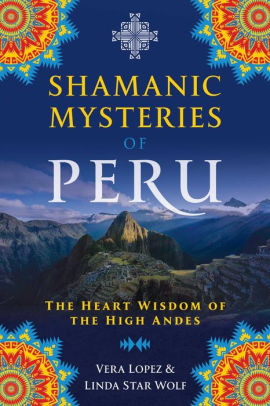The two authors of Shamanic Mysteries of Peru are also tour guide operators and their books seem designed to pique the interest of the reader in going to Peru themselves on one of their guided tours. Lopez and Star Wolf promote a New Age world view and they ascribe to a number of ideas that are foreign to the culture of Peru. They channel spirits and describe psychic information downloads. For example, that beings from the Pleiades contacted the ancient peoples in the Andes and this has a connection to the ancient, mythic cultures of Lemuria and Atlantis. (I read another book by Linda Star Wolf and this is a running theme.) This isn’t a big part of the story but it is important to understanding where the authors stand in relation to the topic.
Readers may learn something about the myths of the Andes and some of the names of the spirits and Gods of this region. I had many questions about Peruvian cosmology that were not answered and I would have liked a lot more information on the myths, holidays, and religious practices. Star Wolf and Lopez claim that the beliefs they describe come from the smallest, most remote group of Quechua speakers, who are known as the Qu’ero people. My research showed in the last census, there were only about 600 hundred Qu’ero people living in several very high-altitude villages. The book claims the people are the last descendants of the Incan rulers of 500 some years ago. The idea that the subsistence farmers of the high altitudes are the descendants of royalty seems designed to appeal to a Western audience who values the beliefs of the rich in contrast to the indigenous beliefs of the poor. Additionally, the size, remoteness and poverty level makes it far easier to get away with spreading false ideas in their name.
The number of inaccuracies throughout the book made it difficult for me to trust what these authors said, especially since their statements were often contradicted by other sources. Trust is imperative when teaching about spiritual practice. If I am to believe that you channeled the ancient spirit Chuma, I better not be doubting you because you claim to have gone from vomiting in a hotel in the morning with altitude sickness to literally climbing up a mountain later the same day. They see it as proof of miracle healing. I see it as dubious.
The two authors switch off on writing sections. It is not always clear who is writing. Vera Lopez is Brazilian born and lives in the US and Linda Star Wolf is American. Both authors are foreigners in Peru. Neither is a native Spanish or Quechua speaker. It is reasonable to wonder how well they communicate with Quechua speakers and to what extent the locals are just giving the tourists what they want. The chapters of the book flow from one ancient Peruvian site to the next. Interspersed are guided meditations to these places. These meditations encourage the reader to form a connection to these places and spirits and some readers may enjoy them. The satisfied tourist testimonials also interspersed provide their viewpoint.
The authors are very positive in their outlook but the historical and archaeological truths run counter to their rosy ideas. They are pitching the idea that the Andes should be visited because the ancient people were highly evolved and spiritual and therefore the visitor can also have an amazing spiritual growth experience by going there. There are inaccuracies in their accounts of historical events. For instance, they claim there was a big cataclysm that destroyed Tiwanaku. No evidence of this exists in history and archaeology. There are inaccuracies in their use of source material. At one point there is the quote by Einstein about imagination being more important than knowledge and the author failed to end the quotation marks before continuing to add her own words to the quote. This could be sloppiness or intentionally misleading. At no point in the book is there mention of human sacrifice, Qhapaq hucha or Capacocha in the Quechua language. Despite the evidence of child mummies found high in the Andes, the authors believe the ancient cultures were spiritually advanced. The mummies do not fit into this narrative and I suspect for this reason are ignored.
When I researched the Qu’ero people, I found that their spiritual beliefs do not fit into a neat box that we know as shamanic practice. Paqos are also seen as being mystics but not hermits. Their role is in service to their community as a part of a larger cultural concept called ayni, or reciprocity, which holds communities in right relationship with each other. The authors touch on this concept of reciprocity. They never explain how paqos function within their own society. They tell how when they give something to Peruvians in the Andes, the locals feel they must give them something back. Most readers will find this ayni to be a foreign custom. I feel that if the authors wanted to really teach about this culture, they would have invested a lot more in explaining ayni.
In the end, Shamanic Mysteries of Peru serves as an elaborate marketing campaign for tourists looking for a unique experience. It takes more than a 10-day tour to know a place truly. It will take more than reading this book to know what lays in the heart of the Andes. I did find this book absurd at times. The lack of good research and the false statements would have prevented me from finishing the book were it not for this review.
Not recommended due to lack of concern for good research and accuracy.
~review by Larissa Carlson
Authors: Vera Lopez & Linda Star Wolf
Publisher: Bear & Company, 2020
pp. 190, $ 18.00

